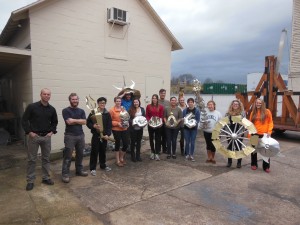Month: December 2015
Group Photo
Aluminum Radiolarians
Waste Mold Casting Method – Daniel Flinchbaugh
Radiolarians and Ernst Haeckel, Amy Patterson
Radiolarians are single-celled, individual microorganisms, similar to amoeba, often shaped with radial symmetry that can survive harsh conditions at the bottom of the sea. To help them survive these conditions, radiolarians contain pseudopods to catch tiny prey for feeding as well as silica, which creates the intricate, glasslike crystalline structures. This helps create the infinite diverse forms that gave them their name of Protists, after the Greek God of the sea, Proteus, who can take on infinite forms. Ernst Haeckel was only introduced to radiolarians in his days of studying science as a medical student at university after he found himself bored with superficial structures and dry specimens in the lab. He was raised Christian but also as a scientist, therefore he was torn between natural law/materialism and God/souls. Haeckel struggled to come to terms with both but worked throughout his career to marry the two divergent concepts through art. This was not a popular concept to unite due to the Christian church holding power over science.
One line that I found fascinating and was repeated throughout the film helped Haeckel understand how form and function can be united. “You must, when contemplating nature, understand that there is no outside or within there is only inside out and outside in.” The form itself produces the function, a concept that he arrives at through producing radiolarian art. Similarly, when creating a sculpture, the form serves a purpose; the form is the purpose. I must understand what output (reaction) will emerge form my sculpture while creating it. Although evolution does not occur through a conscious mind, it does produce forms with an efficient and effective purpose, such as the intricate, single celled microorganism that is the radiolarian.
It was fascinating that Haeckel was able to gather as many specimens as he did and completely replicate their form in art with the limited technology of the 1850’s. At that point, scientists believed that the ocean could not be as deep as 5 miles, and yet, Haeckel found specimens from 5 miles below the surface. Therefore his findings emerged at a time that the church ruled and scientific knowledge was limited. All research voyages at that time had a team of scientists (naturalists and chemists) as well as an artist to accurately depict their findings. This is where Haeckel found a calling as an artistic naturalist or a natural artist. He felt like he could grasp nature through his art, which is one implication of the projects for our class. It is a way for us to create form and function through various artistic mediums, which occurs naturally in nature. I am amazed at how painstaking his task of replicating the complex structures of radiolarians. The size and speed he had to work at was exhausting, and yet he drew out about 4000 radiolarians.













































































